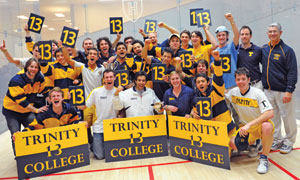
from the president |
1 > |
 Back some twenty years or so, when I was serving as dean of the faculty
and vice-provost at SMU, I had the privilege of working with the best
numbers cruncher of my long career. This fellow, one of our associate
deans, could look at a set of data and extrapolate all manner of
interpretations of random numbers that would perplex the rest of us. One
of his quips, when first looking at some data set, was always
“implausible to the point of being impossible.” As I have remarked over
the years, Trinity has occasioned me to use the good dean’s pithy phrase
often. Thus, when asked about the “implausible to the point of being
impossible” increase in the number of completed applications for the
Class of 2015 (the one that will matriculate this fall), I have relied
upon my former colleague’s reaction because what has transpired here at
our College does in fact fall into his rubric. We have had an
astonishing 48.4 percent increase in applications compared to last year,
something so statistically unique as to be qualified only by the dean’s
turn of phrase.
Back some twenty years or so, when I was serving as dean of the faculty
and vice-provost at SMU, I had the privilege of working with the best
numbers cruncher of my long career. This fellow, one of our associate
deans, could look at a set of data and extrapolate all manner of
interpretations of random numbers that would perplex the rest of us. One
of his quips, when first looking at some data set, was always
“implausible to the point of being impossible.” As I have remarked over
the years, Trinity has occasioned me to use the good dean’s pithy phrase
often. Thus, when asked about the “implausible to the point of being
impossible” increase in the number of completed applications for the
Class of 2015 (the one that will matriculate this fall), I have relied
upon my former colleague’s reaction because what has transpired here at
our College does in fact fall into his rubric. We have had an
astonishing 48.4 percent increase in applications compared to last year,
something so statistically unique as to be qualified only by the dean’s
turn of phrase.
From the vantage point now of nearly seven years as your president, however, a number of data fall likewise into the same category of “implausible to the point of being impossible.” The fall of 2005 witnessed 627 students matriculating here at Trinity, when we had set the admissions target at 570. Then the 2006 Senior Class Gift Committee, co-chaired by Sara Thiede, now Sara Thiede Stevens (whose young son Jake, born a few months ago, has already been accepted by me into the Class of 2033 at his mother’s alma mater), miraculously closed their campaign at a staggering 97 percent participation rate, the highest we could find anywhere in the United States. What Andy Miller of our Advancement Division and Sara (now serving on Trinity’s Board of Trustees as our Funston Trustee) and the other members of the committee accomplished falls, too, into the dean’s category of “implausible to the point of being impossible.” Leaders of American higher education started asking me what was happening at Trinity and how such a demonstrably impossible increase had occurred. I demurred, trying to grasp what possible logical explanations might be proffered as a reasonable response.
We fast forward two years or so to the Trinity College Fund Challenge: against the backdrop of one of the worst economic crises to hit the country and the world since the Great Depression, coupled to a radical shift in philanthropy to every eleemosynary cause imaginable. Even under those conditions, Trinity alumni elected to participate in the Trinity College Fund at an unprecedented 55 percent, up from 47 percent only one year before, positioning Trinity as one of the top six colleges and universities in the entire United States in alumni participation.
How else to explain the completely “implausible to the point of being impossible” thirteenth year in a row for our men’s squash team, after they defeated Yale in a heartstopping set of matches the last weekend of February?
And now back to the Class of 2015, with an “implausible to the point of being impossible” increase of 48.4 percent in completed applications over last year: with rising academic standards being met, historic numbers of international students applying for a place in the class, and equally remarkable diversity representation across the board. How does anyone, including my talented former colleague, possibly account for such dramatic and historic shifts? On one hand, we know anecdotally that the College is seen as a “hot” institution. As one of only two standalone liberal arts colleges located in a major urban environment, Trinity offers our students an unparalleled undergraduate education on a stunningly beautiful campus in an urban environment with outreach to other major urban environments all over the globe. On the other, Trinity continues to advance its mission on a daily basis. There are countless recent examples of this. Thanks to our Communications Office staff and those in information technology, working with the professionals in the admissions arena, we have completely recast our admissions materials, added a number of social networking venues, and now have redesigned our Web site (which I strongly encourage all of you who are reading this column to peruse—you will be astonished, I assure you—www.trincoll.edu).
|
| 1
> |
